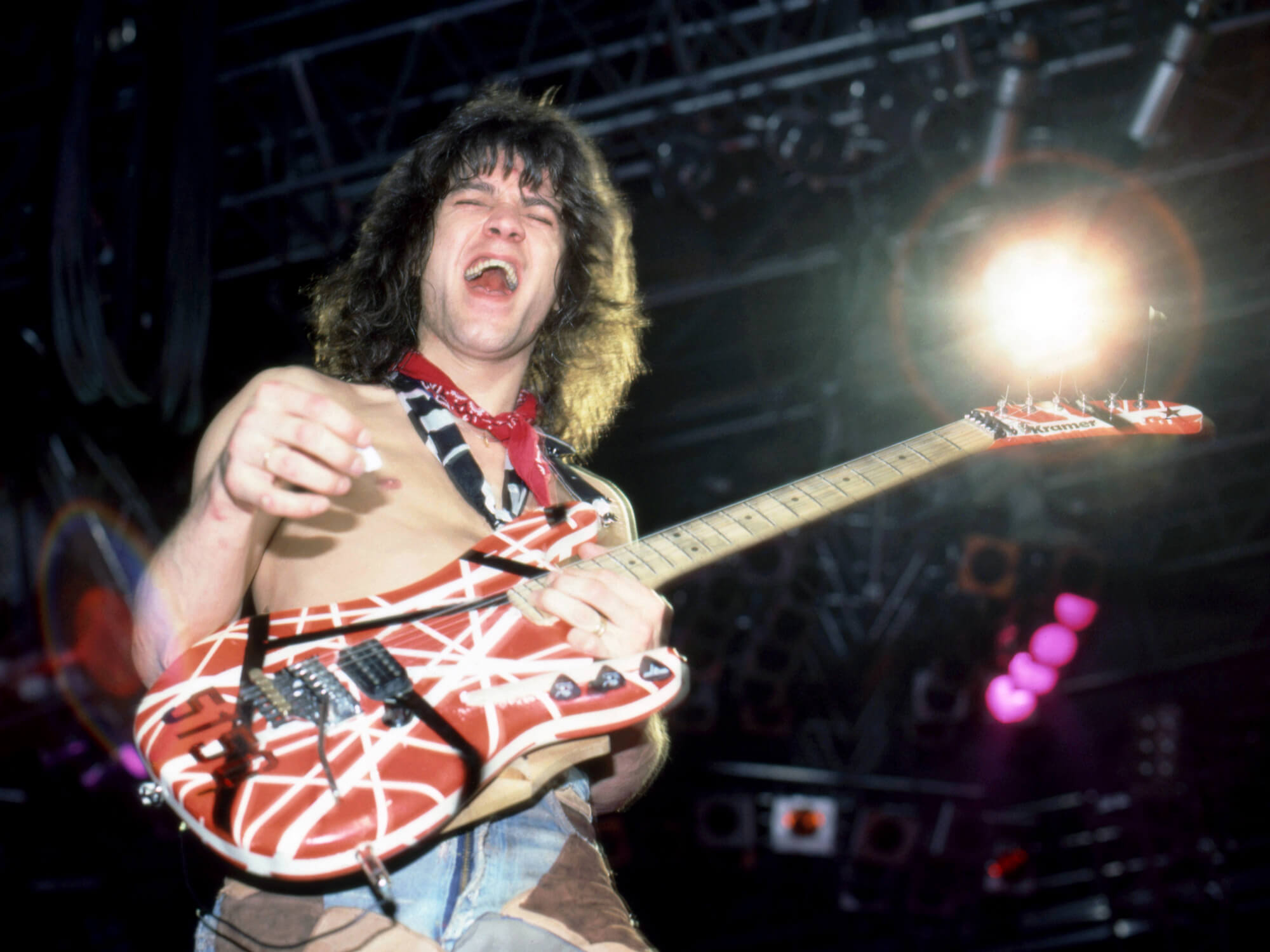A Brief History of Kramer Guitars
It’s a shred guitar icon played by some of the biggest names in 80s shred, but there’s more to Kramer than Superstrats…

Eddie Van Halen live onstage in 1984 with his Kramer Frankenstrat guitar. Image: Ross Marino/Getty Images
The 1980s was a time of rapid change in the music industry. We saw the compact disc facilitate a massive paradigm shift in the way music was created and marketed. The first wave of punk sputtered out and was replaced in the zeitgeist by new genres that often had the synthesizer or the turntable as the fulcrum. But despite this, guitar remained an influential part of the musical landscape, especially with hard rocking bands who pushed the boundaries of both guitar playing and fashion.
Among this new generation of shredders, there was one brand that ruled the 1980s – Kramer Guitars. But despite being forever associated with the 80s and hair metal, the story of Kramer Guitars actually starts in the 70s and a very different type of guitar.
Travis Bean’s name has become synonymous with the unconventional aluminium-necked guitars that bore his name, not to mention their iconic hollow T headstock. But Travis Bean Guitars was not a one-man operation when it started out in California in 1974, in fact Bean started the company with two business partners – Marc McElwee and Gary Kramer.
According to Kramer, the business deal with Travis Bean began to sour when he applied for a patent in his own name rather than the name of the company. Business relationships were strained further when, according to Kramer, guitar construction started to be edged out by Bean’s new passion, drumming.
Again, according to Kramer, Bean had converted a large section of the production floor space into a garage style-recording studio, complete with hundreds of egg cartons on the wall during a weekend when he was supposed to be filling orders to meet the incredible demand for the instrument bearing his name.

One thing that we are certain of is that Kramer left Travis Bean in 1976 to found his own company along with a friend of Bean’s from New York, Dennis Berardi – Kramer Guitars was born,
The initial Kramer prototypes were built by a man named Phillip J. Petillo who was also responsible for the Travis Bean prototypes. Kramer also sought out investors and found one in Henry Vaccaro. Vaccaro later sold his shares of the company in 1993 to Jackson Communications Inc, formed by the family of superstar Michael Jackson (which resulted in a cascade of legal issues that we simply don’t have the space to go into here!).
Between 1976 and 1981, the guitars built under the Kramer banner had some strong resemblance to Travis Bean Guitars – most notably the aluminum necks and the forked headstock design. But Kramer necks featured an important distinction – instead of being built completely out of aluminum, Kramer Guitar necks had wooden inserts placed into the aluminum. This was done for two reasons – weight relief, and to make the necks feel a bit more akin to traditional guitar necks. There may have been some tonal implications to the decision as well.
If you’ve ever used an aluminum necked guitar, you may notice that the first time you pick it up, the neck feels a bit cold. Aluminum conducts heat very well so when you first grab an aluminum neck, it draws the heat from your hand, giving you that cooling sensation, even at room temperature. The wooden inserts, set in epoxy, were usually walnut or maple, while the bodies were made of curly or Birdseye Maple, Koa, Afromosia, Swietenia, Shedua, and Bubinga. The bridges and tuning pegs were made by Schaller and the pickups were supplied by DiMarzio. The cavity covers on the guitars were made of aluminum.

In late 1981, Kramer Guitars ditched the aluminum necks in favor of a more traditional construction design. There has been a lot of speculation as to what prompted this move, but like most things in the guitar business, it’s likely had to do with sales, or a lack of them.
During the years leading up to 1981, the aluminum necked bass guitars were outselling guitars at a rate of about four to one, we can speculate that this was because bass players were more willing to try something new during that era.
In any case, the first batches of guitars to come out with wooden necks featured Fender-shaped headstocks, much like the Charvels of that era. After only a thousand or so instruments were built, in May 1981, Kramer received a cease-and-desist order from Fender to halt the production of guitars with the headstock shape, which would lead Kramer to switch to a “beak” headstock.

During this era, the production of guitar components was moved out of the US. The bodies were made in various factories in Eastern Asia. Tuners and tremolos were made by Gotoh in Japan, and the necks were made by Japan’s ESP Guitars, which started making replacement guitar parts and importing them to the US around the same time – they also made guitar parts for Schecter during that era. All the parts were shipped to New Jersey where they were assembled, and the guitars were finished.
The executive team at Kramer were wise enough to see the trends that were brewing within the music industry, which included the Eddie Van Halen-driven desire for guitars with tremolo systems. Kramer partnered with a German inventor named Helmut Rockinger to build tremolos for their guitars but soon after, in 1982, they partnered with Floyd Rose to build tremolos as well and by 1983 Floyd Rose tremolo equipped guitars were flying off the shelves.
Kramer was using Schaller to produce tuning pegs and they arranged for the company to start producing Floyd Rose tremolos as well. Crucially, Kramer was the only guitar company offering Original Floyd Rose tremolos stock on their production guitars at the time, giving them a massive EVH-sharpened edge when it came to marketing.
In late 1983, Kramer again switched up their headstock design to the somewhat-Gibson Explorer-like “hockey stick” design. Around this time, Kramer came out with a new model, the Baretta which was used on stage by Eddie Van Halen. The EVH partnership with Kramer stemmed from a chance meeting between Dennis Berardi and Eddie Van Halen’s managers when they found themselves on the same flight – but it was an association that would define the brand.

Kramer Guitars continued to evolve to incorporate popular changes in technology such as introducing Seymour Duncan pickups in late 1985 and embracing the bright flashy colors of the glam movement for finishes in the mid to late 80s.
Following Eddie Van Halen’s lead, a lot of prominent guitarists were seen using Kramers such as Mick Mars and Vivian Campbell. Kramer understood the trends of the market and the power of celebrity and combined the two to become the best-selling brand of 1985 and 1986.
The wave crashed in 1991 when the decline of hair metal (thanks in no small part to Slash) combined with an insurmountable number of financial issues, including a lawsuit from Floyd Rose. The company declared bankruptcy and was sold to Gibson.
In the years since Kramer guitars have continued to be made – albeit in small numbers and only in Gibson’s Asian factories, but in the years since the KKR-backed takeover of Gibson Brands following its bankruptcy in 2018, the Kramer band has become more visible. As shred guitar continues to enjoy a renaissance, the future for Kramer might be brighter than it has been in decades.
